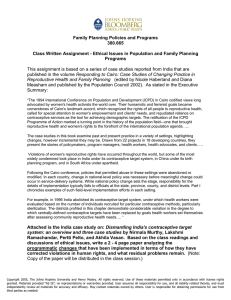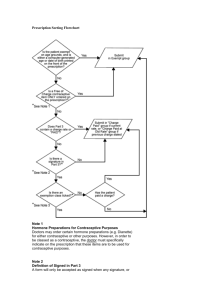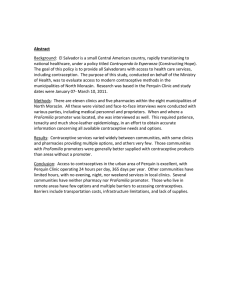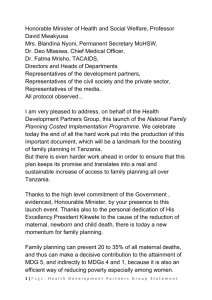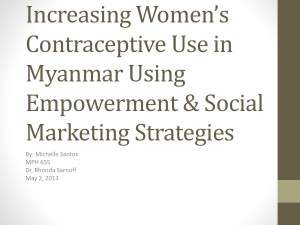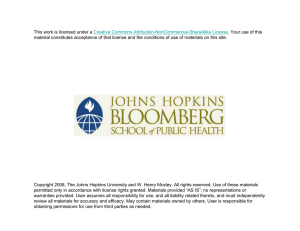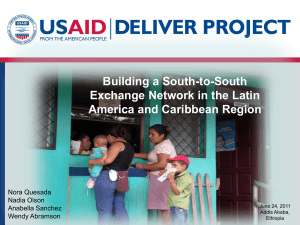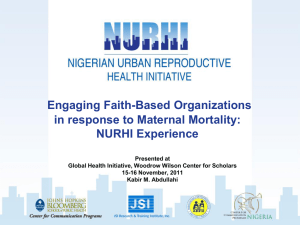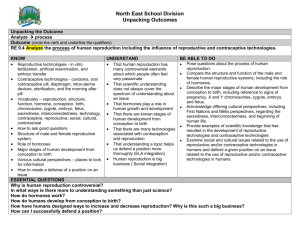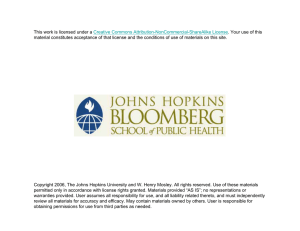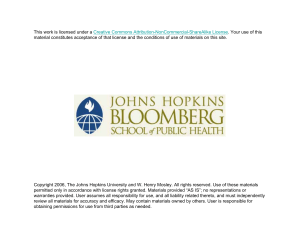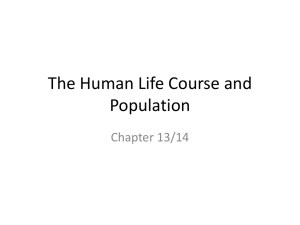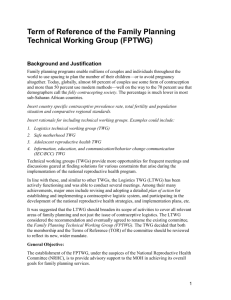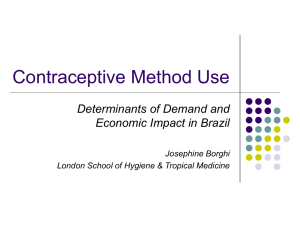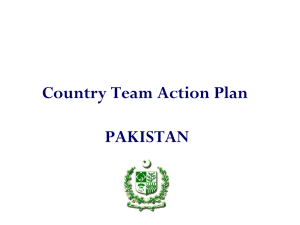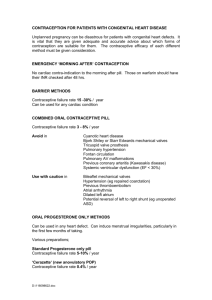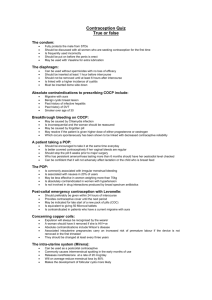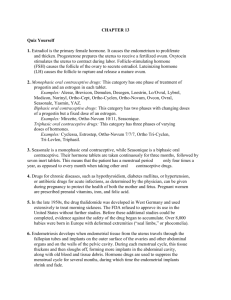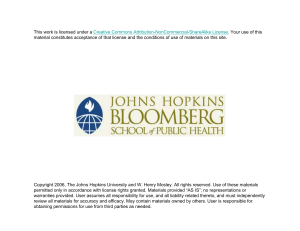Components of Successful Family Planning Programs_0
advertisement
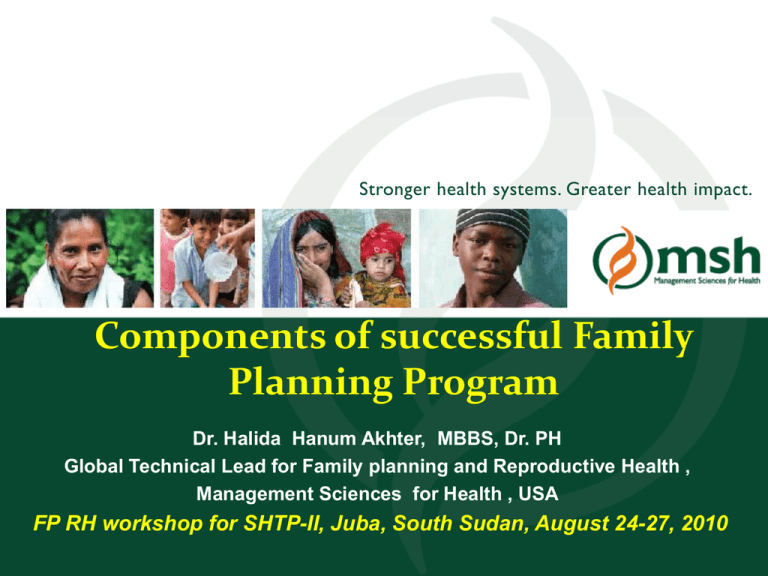
Stronger health systems. Greater health impact. Components of successful Family Planning Program Dr. Halida Hanum Akhter, MBBS, Dr. PH Global Technical Lead for Family planning and Reproductive Health , Management Sciences for Health , USA FP RH workshop for SHTP-II, Juba, South Sudan, August 24-27, 2010 Benefits of Family Planning: Since the 1960’s, family planning (FP) programs have assisted in: Raising the global prevalence of contraceptive use from 10% to 60% Reducing the average fertility in developing countries from six to about three births per woman1-3 Scaling up services to provide FP to all women would prevent: 52 million unintended pregnancies 23 million unplanned births 22 million abortions 7 million miscarriages 1.4 million infant deaths 142,000 pregnancy related deaths 505,000 children from loosing their mother4 Family planning Indicators and management Tools Contraceptive Prevalence rate Birth rate %of births with more than 2-years intervals (spacing) Knowledge of contraceptives methods Utilization rate of modern FP methods % of women in couples with unmet contraceptive needs %of health facilities providing modern FP methods Range of methods provided in health facilities and at the central warehouse Number of staff members trained in FP health facilities Number of FP awareness-raising sessions in schools Number of FP awareness-raising sessions in communities Elements of successful family planning program Supportive government policies Evidence-based programming Strong leadership & good management Effective communication & outreach strategies Contraceptive supply & logistics system Well-trained, supervised & motivated staff Client-centered care for all groups Mix of service delivery points Free or inexpensive services for poor Integration with related health services Access to services FP is offered in both Private and Public Institutions including Community level. There is a strong integration of FP into other services such as HIV services, MCH week, nutrition, Male involvement via ANC services at facility level. Community-based distribution in development, integration of FP into other services, Introduction of community distribution of injectables among others; Special group emphasized- Youth-friendly services exists, Reaching out to men is emphasized, Access to services Free contraceptive commodities in public sector Private Sector/Social marketing Involvement in family planning; Free availability of Long-acting and permanent methods Provider s’ skill and availability FP providers knowledge and skills up-to-date by doing On-the-job-training Task Shifting where nurses can provide long term methods and Capacity Building for health care providers; Care providers turnover issues; Sensitization and BCC Community sensitization efforts (through mass media and other method of community entertainment to discuss the importance of FP and clearing up misconceptions. Open discussions on FP – Empowerment at various levels; Positive media coverage on family planning; Faith based and cultural factors Partnership promotion with both international and local partners Family planning environment A strong political commitment Advocacy is carried out for family planning; Stakeholders supporting the programs; There is Government budget line designed for FP commodities purchase Innovative financing systems such as performancebased financing (health center and community) Community health insurance scheme There is a strong public-private partnership in FP The logistics system ensures contraceptive security Quantification and forecasting performed jointly by all donors under Govt. leadership Well-functioning district procurement and distribution of commodities and supplies in place; Enabling Factors/Achievements Political Commitment for example the involvement and campaign of the 1st Lady on Adolescent Pregnancy; Vocal Leadership to support the existing efforts Supportive Policy environment by the government with service provision guidelines- FP, and integration of family planning services into VCT, PMTCT, ART, home based care, and Adolescent reproductive health; Recognized huge unmet need due to lack of resources. Government Commitment to support reproductive health and family planning programs; Enabling Factors/Achievements Service Delivery Expansion that includes Heath Extension Program (health extension workers supported by community health workers), Provision of Depo Provera and Implanon by health extension workers, and model Families Communities promoting healthy behaviors, including use of family planning; Conducive Policy Environment such as tax exemption on contraceptives- 2007; National Family Planning Implementation Plan Integration FP with other services Integration means offering multiple health care services at the same facility or through a community-based program to benefit clients, providers, and programs. Integrated Services Increase Program Efficiency and Clients’ Convenience Clients. Offering multiple services at one location increases access and convenience for people seeking health care. For example, women with HIV often prefer to obtain family planning from their HIV care provider rather than disclose their HIV status to another health care provider (Cooper et al., 2007 #34). Providers. Integration of services enables providers to address the health of their clients more holistically. Some providers report that they like the opportunity to offer clients multiple services (Babcock, 2004 #12). They caution, however, that adequate resources, training, and support are necessary. Otherwise, the new responsibilities may overburden them. Programs. Integrated services are more efficient and so can serve more people for the same expenditures. Program managers of integrated services report that they avoid duplication of effort and save money that might have been spent maintaining separate facilities (Kane et al., 2005 #101). Family Planning Program Challenges Commodity stock-outs at Facilities hence the need to promote long term and permanent methods; Community based distribution not done; FP program is largely donor driven; Inadequate resources for procurement of quality contraceptives and capacity building of service providers; Inadequate skilled health workers for provision of long term methods IUD and Implants; Inadequate demand creation activities at various levels; Socio-cultural inhibitions as a barrier to the family planning program; Lack of male involvement in family planning programs; and Weak partnership with private health facilities. Best practices : Bringing Family Planning to Every Door step through Health Extension Program with majority women as part of task shifting. Community level intervention on demand creation, referral and access to services in States with high unmet need in Family planning. Inclusion of FP service in National health Insurance scheme/Community based health insurance scheme; Community based Depo- provera injectable contraceptive method-piloted; Pilot use of standard day’s method using Cycle beads; Recommendations: Increase budgetary allocation for FP by the government; Scale up of Community based distribution of FP services; Demand creation activities such as community sensitization; Integrated Maternal Newborn and Child health (IMNCH) budget line 2010; Functional contraceptive logistics management system with user fee; Forecast of 5 years contraceptive requirement done;
